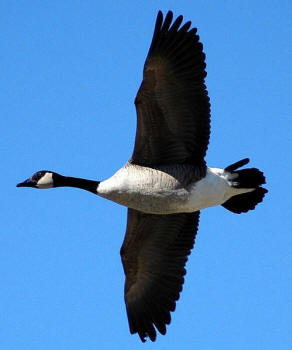< BACK |
NEXT> |
Manitoba Scenery Photo Tour
Manitoba Wildlife: Birds
Photo: Great Grey Owl
The great gray owl was adopted as Manitoba's provincial bird on July 16, 1987.

© Leanne
Guenther, used with permission
Photo: Bald Eagle
Although the Bald Eagle is the USA's national bird, most of it's breeding grounds are located in Canada, including the entire province of Ontario.
The bald eagle is the only eagle exclusive to North America. They are Canada’s largest bird of prey and have no natural enemies.
Bald eagles choose one mate for life. To impress each other, males and females perform special courtship dances in the sky. This dance involves locking their talons together and cart-wheeling through the air.
When a bald eagle loses a feather on one wing, it will lose a feather on the other in order to keep its balance.
Bald Eagle information and coloring page

Source: wikipedia - photo by Mcanbolat
Photo: Canada Geese
One of my favorite spring and autumn memories ever since my early childhood was hearing the honk of the Canada Geese. I'd peer up at the sky and look for the telltale V-formation of the flock of geese returning to Canada for the summer or leaving for the winter. This spring, I couldn't help but smile when I noticed my daughters straining their necks in search of the geese.
Canada Goose Coloring Page (with information)
more about the Canada Goose >

photo by Aaron Logan, used with permission
Photo: Great Blue Heron
The great
blue heron is the largest heron in North America -- and
they're actually more grey than blue. These
birds are common through most of North America. Most head south once water begins to freeze.
Some fly as far south as Mexico or Cuba.
The great
blue heron is found near bodies of water including
rivers, lakes and oceans as their main diet consists of
fish. They typically nest on small islands near the
water.

source: Wikipedia - photo by Matt MacGillivray
Photo: Pacific Loon
The Pacific loon (also known as the Common Loon or Great Northern Loon) is one of five loon species and perhaps the most abundant loon in North America. It closely resembles the Arctic loon and until recently, the two loons were considered the same species.
The Pacific loon prefers to live in deep water and are found in northern Ontario nesting near the Hudson's Bay coast.
Loons are built for swimming. They are awkward on land and can only take flight from water. Although they lack ability on land, they're terrific in the water -- able to dive up to 70 meters deep in search of fish. Perhaps for this reason, they usually dive under water rather than flying away when they sense danger.
Pacific Loon information and coloring page

source wiki commons - photo by Boral
Photo: Snowy Owls
Snowy owls are mainly white
with some black or dark brown markings. Since snowy owls are
found in colder climates, they have a thick layer of down
underneath their many layers of feathers to keep themselves warm
in even the most frigid temperatures.
Snowy owls nest in
the arctic during the time of year when it is daylight for most
of the day. Likely because of this, snowy owls are the only type
of owl that sleep at night and hunt during the day (all other
owls come out at night).
Snowy owls visit every province
of Canada during the winter - they tend to nest and breed
during summer in the more northern areas of the country.
Snowy Owls information and coloring page
